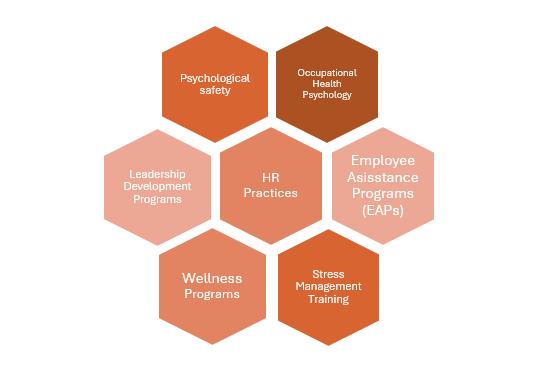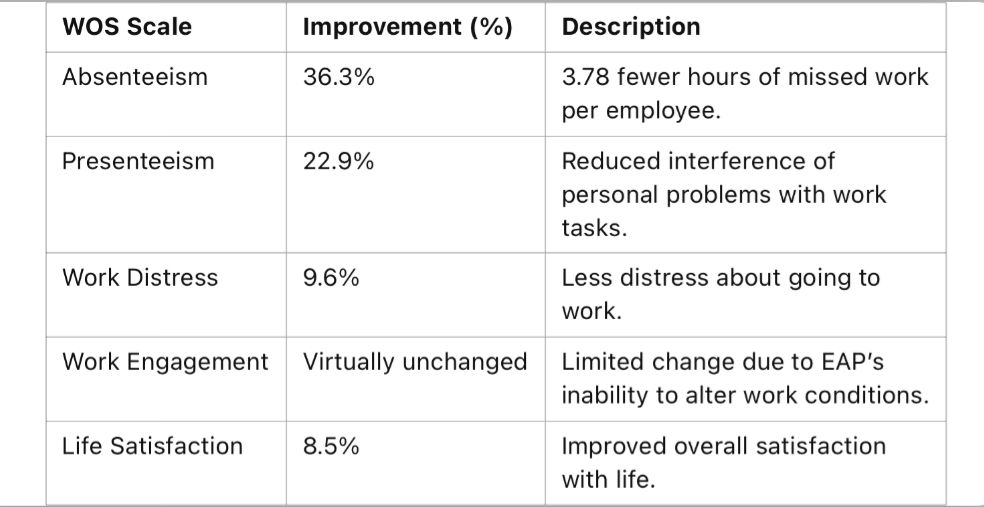By Semra Delić, Supervision by Dr. Anna Rostomyan
Introduction
Emotional well-being and mental health of employees have become an increasing concern over the last few years. The modern workplace have witnessed a significant transformation. Employee well-being has increasingly gained attention in modern organizational practices, especially within human resource management. With a growing recognition of its impact on productivity, mental health, and job satisfaction, many organizations are investing in strategies that focus on enhancing the psychological health of their workforce. Mental health is a state of well-being in which an individual realizes their own potential, can cope with the normal stresses of life, can work productively, and is able to make a contribution to their community (Herrman et al., 2004). Programs like Employee Assistance Programs (EAPs), leadership development, and promoting psychological safety are just a few methods used to address these needs.
This article will explore the various ways HR practices influence mental health in the workplace. It will highlight the importance of implementing psychological safety and mental health initiatives, as well as the role of EAPs and leadership development in improving employee well-being, preventing burnout, and fostering a supportive work environment. Case studies, such as Caterpillar’s hybrid EAP model, will provide insight into how these strategies are applied and the benefits they bring to both employees and organizations.
Importance of emotional well-being
Outside the field of organizational sciences, “happiness” is often understood as psychological well-being (PWB), which is sometimes referred to as personal or subjective well-being. PWB is generally described as the overall effectiveness of an individual’s psychological functioning. Unlike job satisfaction, which includes both cognitive and emotional components, PWB is primarily an emotional experience. It refers to the ability to manage emotions effectively, and cope with the challenges and stresses of daily living.
Relationship between job satisfaction and performance
For decades, researchers have explored the theory that happiness and job satisfaction are directly linked to productivity, with studies dating back to the early 20th century consistently examining this relationship. Two primary theories emerge from the literature a) Human Relations Theory, and b) Emotion theory. Let us have a closer look at the two:
- Human Relations Theory originating nearly a century ago, suggests that higher employee well-being, often assessed through job satisfaction, fosters higher morale, which subsequently enhances productivity.
- Emotion Theory suggests that positive emotions and moods enhance motivation and performance, either directly or by influencing attitudes and behaviours. These frameworks highlight the significant impact of well-being on workplace outcomes.
Burnout
The adage “Happier workers work better” serves as a driving motivation to Human Resources departments to create a healthy and psychologically safe workplace for the employees. One of the main issues standing in the way of employees being happy is burnout. Maslach and Jackson (1981) conceptualized job burnout as a stress syndrome with three dimensions: emotional exhaustion, depersonalization, and a diminished sense of personal accomplishment. It is a state of chronic physical, emotional and mental exhaustion. Burnout is not just about being tired, it represents a deeper crisis in which stress exceeds an individual’s capacity to cope effectively. Burnout has been a prevalent issue for a long time, but it is only in recent times that it has gained attention. Historically, the concept of burnout was not fully understood or acknowledged, and workers often pushed through stress and exhaustion without considering the long-term impact on their health or productivity. In many cultures, especially in highpressure industries, there was an expectation of constant output, and signs of burnout were often seen as personal failings rather than systemic issues. However, as awareness of mental health and well-being has grown, burnout has increasingly been recognized as a serious concern. The impact of burnout on productivity, job satisfaction, and overall health has prompted companies and HR professionals to take more proactive measures in addressing the issue.
HR Strategies for Fostering Mental Health
In recent years, organizations have begun to prioritize employee well-being, implementing strategies such as mental health support programs, stress management workshops, and policies promoting work-life balance. There is also a growing emphasis on creating psychologically safe environments where employees feel supported, heard, and empowered to manage their workloads effectively.
Figure 1. Created by the author

Psychological safety
Psychological safety is described by Edmondson (1999) as the “shared belief held by members of a team that their team is safe for interpersonal risk taking – that others will not embarrass, reject, or punish them for speaking up”. Psychological safety is broadly defined as a climate in which people are comfortable expressing and being themselves. More specifically, when people have psychological safety at work, they feel comfortable sharing concerns and mistakes without fear of embarrassment or retribution. They are confident that they can speak up and won’t be humiliated, ignored, or blamed. They know they can ask questions when they are unsure about something. Psychological safety is an essential component of a healthy and highperforming workplace culture. When organizations prioritize it, they tend to experience lower turnover rates, higher employee engagement, and improved productivity. Employees in such environments feel valued, respected, and supported, which leads to greater job satisfaction and better overall performance. In contrast, a lack of psychological safety can foster a toxic work environment. Employees may become hesitant to speak up, share their ideas, or voice concerns, which stifles innovation and creativity. This is especially harmful for marginalized or underrepresented groups, who may already feel vulnerable or excluded, making them even more reluctant to express themselves in a psychologically unsafe environment.
HR practices play a crucial role in implementing psychological safety. Behaviourally, psychological safety leads employees to engage in open communication, voice their concerns, and seek greater feedback; all of which are interpersonally risky behaviors (Pearsall & Ellis, 2011). HR can also promote inclusivity by ensuring that all employees, especially those from marginalized groups, feel heard and valued. Training programs on empathy, bias reduction, and conflict resolution are often part of this approach, helping to create an environment of trust and respect. By embedding these practices into organizational culture, HR can help ensure that psychological safety becomes a foundational element of the workplace. This shift reflects a broader cultural change that recognizes the importance of sustainable working conditions for long-term success, both for employees and organizations alike. By implementing psychological safety in the workplace HR ensures reduction of stress and anxiety, enhanced emotional wellbeing, lower risk of burnout, encouragement of help-seeking behavior, positive organisational culture, increased job satisfaction and motivation which then sums up to positive impact on employees’ mental health.
Occupational Health Psychology
Occupational Health Psychology is a field that is increasingly utilized by HR departments to improve mental health of employees within organizations. Occupational health psychology (OHP) is an interdisciplinary field focused on the well-being—specifically health and safety— of individuals in the workplace. Worker well-being is a crucial outcome for the employees themselves, as good health and safety directly impact their personal lives. Management often prioritizes employee well-being, recognizing that it can lead to valuable organizational outcomes such as lower healthcare costs, reduced absenteeism and turnover, and increased productivity. Thus, worker health is vital not only to the individual and the organization but also to society, as it affects national healthcare costs, productivity, and overall quality of life.
Employee Assistance Programs (EAPs)
These programs provide confidential counseling and support for employees facing personal problems, including mental health issues, substance abuse, and work-life balance challenges. Research consistently demonstrates that EAPs provide a significant return on investment by reducing absenteeism, improving employee productivity, and addressing mental health issues effectively, thereby enhancing overall organizational performance (Attridge, 2009). HR promotes and administers these services to help employees manage stress and maintain mental well-being.
Wellness Programs
HR may implement initiatives focused on improving employees’ physical and mental health. Examples include fitness challenges, meditation sessions, ergonomic assessments, or providing resources for healthy eating. These programs are designed to improve employee well-being, reduce absenteeism, and increase overall productivity.
Stress Management Training
HR offer stress management workshops or seminars to teach employees techniques for coping with workplace stress, building resilience, and improving time management skills. This helps reduce burnout and improve overall job satisfaction.
Leadership Development Programs
HR often provides training for managers and leaders to enhance their emotional intelligence, communication, and conflict resolution skills. Leadership development programs have been shown to enhance leaders’ skills, foster team cohesion, and improve organizational effectiveness by creating a culture of trust and empowerment” (Day, 2000). These programs aim to help leaders create a positive work environment and manage teams more effectively, which directly impacts employee morale and productivity.
Case Study:
Evaluating the Impact of Caterpillar’s Employee Assistance Program (EAP) on Workplace Outcomes
Employee Assistance Programs (EAPs) have become a cornerstone in supporting employee well-being, particularly in addressing work-related and personal challenges. Caterpillar, a leading manufacturer, conducted a study to evaluate the effectiveness of its EAP in improving work performance and overall life satisfaction. This case study details the methodology, findings, and implications of the study.
Study Design
The study used a repeated-measures design to assess changes in five workplace outcome scales (WOS) before and after the utilization of EAP services. Key aspects of the study included:
- Data Collection: Initial data were gathered during EAP intake, while follow-up data were collected 90 days post-EAP service (Caterpillar Inc., 2015).
- Participants: Only employee clients (excluding family members) were included, with no incentives for participation (Caterpillar Inc., 2015).
- Methodology: Each participant served as their own control, reducing the influence of demographic and clinical factors (Caterpillar Inc., 2015).
- Limitations: The study lacked a comparison group, and potential biases due to non-random sampling and self-selection could not be fully examined (Caterpillar Inc., 2015).
The primary goal was to determine whether improvements in work performance persisted three months after using the EAP.
Results
The analysis revealed statistically significant improvements in several workplace and life satisfaction metrics (Caterpillar Inc., 2015). The table below summarizes the findings:

Discussion
The results of the study revealed significant improvements in absenteeism, presenteeism, and work distress, along with a modest increase in life satisfaction. These findings suggest that Employee Assistance Programs (EAPs) can play a crucial role in enhancing key workplace outcomes.
Notably, absenteeism showed the most improvement, indicating that addressing personal issues through the EAP may help reduce the time employees take off work. Similarly, presenteeism was reduced, implying that employees were able to focus better on their tasks as personal problems had less of an impact on their work.
However, the study found no substantial change in work engagement. This may reflect the limitations of EAPs, which, while effective at supporting individual well-being, may not have the capacity to directly address larger organizational factors that influence engagement.
These outcomes align with other studies that suggest hybrid EAP models, particularly those emphasizing face-to-face services, can provide notable benefits in improving employee productivity and reducing workplace stress.
Conclusion
Caterpillar’s EAP proved effective in enhancing employee well-being and improving workplace outcomes. The study highlights the value of EAPs in addressing absenteeism, presenteeism, and work distress, as well as their role in fostering overall life satisfaction (Caterpillar Inc., 2015). These findings underscore the importance of integrating EAPs into organizational strategies to promote a healthier, more productive workforce.
Organizations leveraging similar hybrid EAP models can expect comparable benefits, particularly when focusing on personalized and accessible services. However, broader systemic interventions are needed to address areas like work engagement that extend beyond the EAP’s scope.
Conclusion
In conclusion, HR plays a vital role in shaping employee mental health by implementing programs and fostering a workplace culture that prioritizes well-being. Employee Assistance Programs (EAPs), such as the hybrid model used by Caterpillar, are a prime example of how HR can support employees through both onsite and offsite counselling services. By addressing personal challenges that affect work performance, EAPs help employees overcome issues like stress, burnout, and anxiety, which can otherwise hinder productivity and engagement. These programs not only support employees’ mental health but also contribute to a healthier, more productive workforce. However, the effectiveness of EAPs and other mental health initiatives relies heavily on the environment in which they are delivered. Creating a psychologically safe workplace is crucial to ensure that employees feel comfortable accessing these services. Prioritizing mental health is not just a benefit for employees; it’s a key factor in building a resilient, engaged, and high-performing workforce.
About the Author
Semra Delić is 26 years old with a Bachelor of Science degree in Psychology and in currently pursuing Master’s degree in Business Psychology at the Media University in Frankfurt am Main. Her research interests are related to emotional well – being and mental health. Her business article describes how HR practices influence mental health at work.
References
-
Herrman, H., Saxena, S., & Moodie, R. (2004). Promoting mental health: concepts, emerging evidence, practice [Dataset]. In PsycEXTRA Dataset. https://doi.org/10.1037/e538802013009
-
Maslach, C, & Jackson, S. E. (1981). The measurement of experienced burnout. Journal of Occupational Behaviour, 2, 99-113.
-
Edmondson, A. C. (1999). Psychological safety and learning behavior in work teams. Administrative Science Quarterly, 44,350–383.
-
Pearsall, M. J., & Ellis, A. P. J. (2011). Thick as thieves: The effects of ethical orientation and psychological safety on unethical team behaviour. Journal of Applied Psychology, 96,401–411.
-
Attridge, M. (2009). Employee Assistance Programs: A Research‐Based Primer. International handbook of work and health psychology, 383-407.
-
Day, D. V. (2000). Leadership development:: A review in context. The leadership quarterly, 11(4), 581-613.
-
Workplace mental health – caterpillar. (2015). https://workplacementalhealth.org/casestudies/caterpillar





































